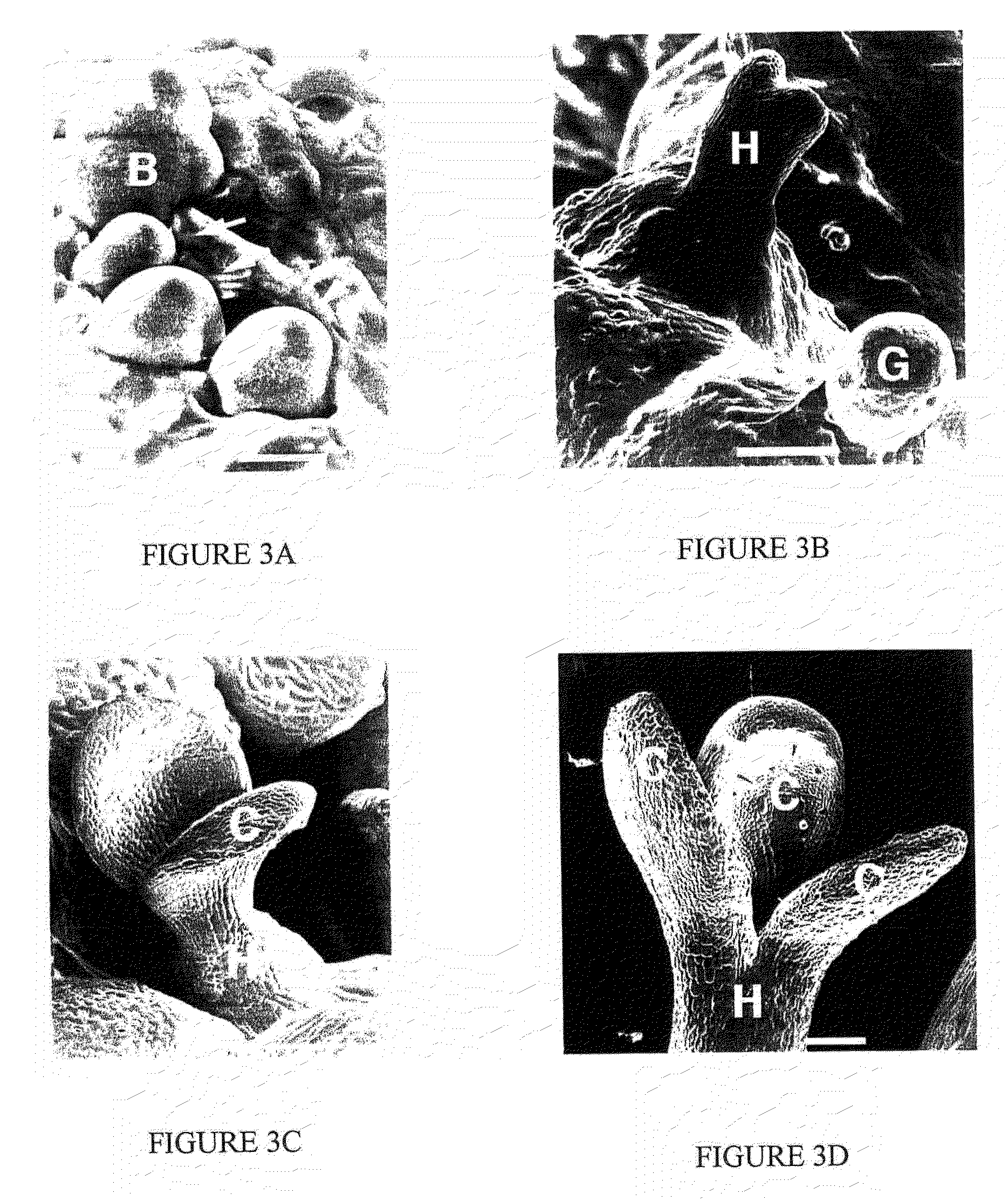Promotion of somatic embryogenesis in plants by Wuschel gene expression
a technology of somatic embryogenesis and wuschel gene, which is applied in the field of promotion of somatic embryogenesis in plants by wuschel gene expression, can solve the problems of severe abnormal plant growth and development, little is known about the signal transduction pathway, and the fate of embryo-like structures remains unknown
- Summary
- Abstract
- Description
- Claims
- Application Information
AI Technical Summary
Problems solved by technology
Method used
Image
Examples
example 1
Plant Materials, Growth Conditions and Plant Transformation
[0035]The Wassilewskija, Columbia and Landsberg ecotypes of A. thaliana were used. Plants were grown under continuous white light at 22° C. on solid A medium (1×MS salts (Murashige and Skoog, 1962), 3% sucrose, 0.8% agar) supplemented with appropriate antibiotics and / or the inducer 17-β-estradiol. Unless indicated otherwise, 5 μM 17-β-estradiol was used for induction. In planta transformation of Arabidopsis plants (the Columbia ecotype) was performed as described by Bechtold et al. (1993). Transformation of root explants was carried out according to Koncz et al. (1989).
[0036]Light and electron microscope analyses were carried out as previously described (Zuo et al., 2000b).
example 2
Screening of pga Mutants
[0037]Agrobacteria ABI cells carrying pER16 were used to transform Arabidopsis (the Wassilewskija ecotype) root explants. Infected root explants were cultured on the screening medium (SCM; 1×MS salts, 1% sucrose, 0.5 g / L MES (2-[N-morpholino]ethanesulfonic acid), 0.15 mg / L IAA (indole acetic acid), 5 μM 17-β-estradiol, 50 mg / L kanamycin, 100 mg / L carbenicillin and 0.2% phytagel, pH 5.7) at 22° C. under a 16-hour white light / 8-hour dark cycle. Putative pga mutants, which appeared as rapidly growing green-yellowish or green cell clumps or calli upon culturing on the SCM for 10-15 days, were transferred onto a non-inductive shoot induction medium (SIM; for green calli; 1×MS salts, 1% sucrose, 0.5 g / L MES, 1 mg / L 2-IP (N6,δ2-isopentenyladenine), 0.15 mg / L IAA, 50 mg / L kanamycin, 100 mg / L carbenicillin and 0.2% phytagel, pH 5.7) to recover mutant shoots. The green-yellowish calli were transferred onto the callus induction medium (CIM; 1×B5 salts (Sigma), 2% glucos...
example 3
Molecular Manipulations
[0038]Molecular manipulations were performed as specifically stated or by the methods as taught by Sambrook et al. (1989). The XVE inducible expression vector pER10 is identical to pER8 (Zuo et al., 2000a) except that the hygromycin selectable marker of pER8 was replaced with a kanamycin selectable marker. To construct the mutagenesis vector pER16, pER10 was digested with SpeI and Asp718I followed by Klenow enzyme fill-in reaction and religation. The resulting pER16 vector lacked the rbcsS3A polyA addition sequence of the OLexA-46::T3A expression cassette (see FIG. 1 of Zuo et al. (2000a)).
[0039]pER16 is shown in FIG. 1. Only the region between the Right Border (RB) and Left Border (LB) is shown (not to scale). Two transcription units and the OLexA-46 promoter are located between the RB and LB. In the first transcription unit, the G10-90 promoter (Ishige et al., 1999) drives the XVE fusion gene terminated by the rbcs E9 polyA addition sequence. The second tran...
PUM
 Login to View More
Login to View More Abstract
Description
Claims
Application Information
 Login to View More
Login to View More - R&D
- Intellectual Property
- Life Sciences
- Materials
- Tech Scout
- Unparalleled Data Quality
- Higher Quality Content
- 60% Fewer Hallucinations
Browse by: Latest US Patents, China's latest patents, Technical Efficacy Thesaurus, Application Domain, Technology Topic, Popular Technical Reports.
© 2025 PatSnap. All rights reserved.Legal|Privacy policy|Modern Slavery Act Transparency Statement|Sitemap|About US| Contact US: help@patsnap.com



